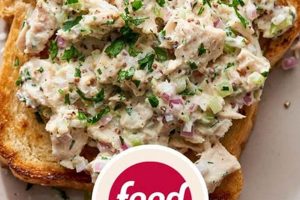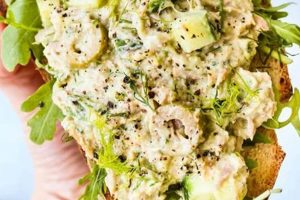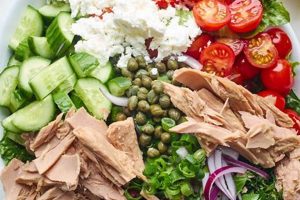A superior tuna macaroni salad involves a harmonious blend of high-quality ingredients and thoughtful preparation. This typically includes perfectly cooked pasta, premium canned tuna, crisp vegetables like celery and onion, and a creamy, flavorful dressing. A well-executed version might incorporate nuanced additions such as hard-boiled eggs, fresh herbs, or a touch of lemon juice for brightness.
Achieving an exemplary version of this classic dish offers several advantages. It can provide a satisfying and protein-rich meal or side dish, suitable for picnics, potlucks, or light lunches. A well-balanced recipe can also offer nutritional benefits by incorporating a variety of vegetables and lean protein. Historically, tuna salad gained popularity as a convenient and affordable meal option, and variations incorporating pasta further extended its versatility. Its enduring popularity speaks to its adaptability and broad appeal.
The following sections will delve into specific techniques for optimizing ingredient selection, achieving the perfect pasta texture, creating a balanced dressing, and incorporating creative variations to elevate this culinary staple.
Tips for an Exceptional Tuna Macaroni Salad
Elevating tuna macaroni salad from ordinary to extraordinary involves careful attention to detail. The following tips offer guidance on achieving optimal flavor and texture.
Tip 1: Pasta Selection and Cooking: Opt for small pasta shapes like elbows, shells, or rotini, which hold the dressing well. Cook pasta al dente to maintain a firm texture and prevent a mushy salad.
Tip 2: High-Quality Tuna: Select tuna packed in water or olive oil, draining excess liquid thoroughly. Solid or chunk light tuna generally offers the best balance of flavor and texture.
Tip 3: Crisp Vegetables: Finely dice celery, red onion, and other desired vegetables. Soaking diced red onion in cold water for a few minutes can mellow its flavor.
Tip 4: Balanced Dressing: Utilize a combination of mayonnaise, plain Greek yogurt, or a lighter alternative for a creamy base. Enhance the dressing with a touch of Dijon mustard, lemon juice, or apple cider vinegar for added complexity.
Tip 5: Flavorful Enhancements: Incorporate chopped fresh herbs like dill, parsley, or chives. Hard-boiled eggs, chopped pickles, or a dash of hot sauce can add depth and interest.
Tip 6: Seasoning: Season generously with salt, black pepper, and other spices like paprika or celery seed. Taste and adjust seasonings throughout the preparation process.
Tip 7: Chilling Time: Allowing the salad to chill for at least 30 minutes allows the flavors to meld and enhances the overall experience.
By focusing on these key elements, one can create a tuna macaroni salad that is both flavorful and visually appealing. Attention to detail in each step ensures a satisfying culinary outcome.
By applying these insights, a truly remarkable dish can be achieved. The following section offers concluding thoughts on creating a personalized and memorable culinary experience.
1. High-Quality Ingredients
Ingredient quality directly impacts the overall taste and experience of tuna macaroni salad. Substandard tuna, limp vegetables, or generic mayonnaise can result in a bland and unappetizing dish. Conversely, using premium tuna packed in olive oil, crisp, freshly chopped vegetables, and a flavorful mayonnaise or dressing elevates the salad to a new level. The inherent flavors of each component shine through, creating a more complex and satisfying culinary experience. For example, using ripe, in-season tomatoes contributes a sweetness and juiciness absent from out-of-season or conventionally grown alternatives. Similarly, opting for high-quality tuna, with a firm texture and robust flavor, noticeably enhances the overall taste profile.
The practical significance of using high-quality ingredients extends beyond mere flavor enhancement. Fresh, well-sourced ingredients often offer greater nutritional value, contributing to a healthier meal. Investing in better ingredients can also reduce the need for excessive seasoning or additions, allowing the natural flavors to take center stage. Consider the difference between freshly ground black pepper and pre-ground peppercorns. The former provides a vibrant, pungent aroma and taste, while the latter often lacks the same intensity. This principle applies across all components of the salad, highlighting the transformative potential of quality ingredients.
Ultimately, achieving a truly exceptional tuna macaroni salad requires prioritizing ingredient quality. This commitment translates to a superior sensory experience, enhanced nutritional value, and a deeper appreciation for the culinary art form. While cost considerations may arise, the difference in taste and overall enjoyment often justifies the investment. Choosing high-quality ingredients is an essential step towards creating a memorable and satisfying dish.
2. Balanced Flavors
Balance constitutes a cornerstone of a superlative tuna macaroni salad. The interplay of creamy, tangy, savory, and subtly sweet elements distinguishes a truly exceptional salad from a mediocre one. An overabundance of mayonnaise can lead to a cloying richness, while excessive acidity from vinegar or lemon juice can overwhelm the other flavors. A successful recipe harmonizes these contrasting notes, creating a cohesive and enjoyable taste experience. The careful calibration of flavors ensures that no single element dominates, but rather contributes to a complex and nuanced flavor profile.
Consider the interplay between the richness of mayonnaise, the briny salinity of tuna, the piquancy of onion, and the sweetness of relish. Each ingredient plays a distinct role, contributing to a balanced whole. The creamy dressing provides a foundation, while the tuna offers savory depth. The onion introduces a sharp counterpoint, and the relish adds a touch of sweetness to round out the flavor profile. When these elements are in harmony, the result is a symphony of flavors that delight the palate. Conversely, an imbalance can lead to a dish that is either too rich, too acidic, or lacking in depth.
Achieving this balance requires careful consideration of ingredient proportions and flavor combinations. A classic approach involves combining mayonnaise with a touch of Dijon mustard for tang, lemon juice for brightness, and seasonings like celery seed or paprika for complexity. The quantity of each ingredient must be adjusted to complement the others, ensuring that no single flavor overpowers the rest. Ultimately, a well-balanced tuna macaroni salad offers a nuanced and satisfying culinary experience, demonstrating the importance of thoughtful ingredient selection and preparation.
3. Optimal Texture
Texture plays a critical role in the overall enjoyment of tuna macaroni salad. A successful recipe balances contrasting textures, creating a harmonious and satisfying sensory experience. The interplay of creamy, crunchy, and tender elements distinguishes a truly exceptional salad from a less appealing version. Achieving optimal texture involves careful consideration of ingredient selection, preparation techniques, and the balance of components.
- Pasta Firmness
Overcooked pasta results in a mushy, unappetizing salad. Conversely, undercooked pasta offers an unpleasant, hard texture. The ideal pasta texture is al dentefirm to the bite yet tender. This requires precise cooking times and immediate cooling to halt the cooking process. Properly cooked pasta provides a pleasant chewiness that complements the other ingredients.
- Vegetable Crispness
Fresh, crisp vegetables, such as celery and onion, contribute a satisfying crunch to tuna macaroni salad. Limp or soggy vegetables detract from the overall enjoyment. Maintaining vegetable crispness involves careful selection, proper storage, and incorporating them into the salad relatively close to serving. This prevents them from becoming waterlogged and maintains their textural integrity.
- Tuna Flake Size
The size of the tuna flakes influences the texture of the salad. Large, intact chunks provide a more substantial bite, while smaller, shredded pieces offer a softer texture. The desired flake size depends on personal preference and the overall balance of the salad. Some recipes benefit from a combination of chunk and flake tuna for textural variety.
- Dressing Consistency
The dressing should be creamy and smooth, coating the pasta and vegetables evenly without being excessively thick or runny. A thick dressing can make the salad heavy and gloppy, while a thin dressing fails to bind the ingredients together. The ideal consistency allows the dressing to cling to the other components, ensuring a balanced distribution of flavor and moisture.
By addressing these textural elements, a tuna macaroni salad transcends mere sustenance and becomes a truly enjoyable culinary experience. A well-executed salad offers a delightful interplay of textures, enhancing its appeal and demonstrating a mastery of culinary technique. The balanced combination of these elements is what distinguishes a truly memorable dish.
4. Proper Chilling
Proper chilling is integral to a superlative tuna macaroni salad. Chilling allows the flavors to meld and deepen, transforming individual components into a cohesive whole. This process enhances the overall taste experience, creating a more complex and satisfying flavor profile. Without adequate chilling, the salad’s flavors remain disjointed, lacking the nuanced harmony achieved through proper refrigeration. For example, a freshly made salad may taste predominantly of mayonnaise, with the other flavors muted. After chilling, the tuna, vegetables, and seasonings emerge, creating a more balanced and integrated taste.
The practical implications of proper chilling extend beyond flavor development. Chilling also firms the pasta, enhancing the salad’s textural appeal. Cold temperatures solidify the dressing, preventing it from becoming watery or separating. This contributes to a more cohesive and visually appealing salad. Furthermore, chilling inhibits bacterial growth, ensuring food safety and extending the salad’s shelf life. A properly chilled salad remains safe to consume for several days, minimizing food waste and maximizing convenience. Conversely, a salad left at room temperature becomes a breeding ground for bacteria, posing health risks and compromising its quality.
In summary, chilling is not merely a final step but a crucial stage in crafting an exceptional tuna macaroni salad. It is essential for flavor development, textural enhancement, and food safety. Understanding the impact of chilling allows for informed preparation and optimal enjoyment of this classic dish. Failure to properly chill compromises both the sensory experience and the safety of the salad, highlighting the significance of this often-overlooked step.
5. Creative Variations
A truly exceptional tuna macaroni salad transcends the basic formula through creative variations. These additions and adaptations elevate the dish from commonplace to extraordinary, showcasing culinary ingenuity and personalized flavor preferences. While a classic recipe provides a solid foundation, exploring variations allows for customization and a more dynamic culinary experience. Creative variations can introduce novel flavor profiles, textural contrasts, and visual appeal, enhancing the overall enjoyment and memorability of the dish.
- Global Influences
Incorporating global flavors expands the possibilities of tuna macaroni salad. A Mediterranean twist might include Kalamata olives, feta cheese, and a lemon-herb vinaigrette. An Asian-inspired version could incorporate soy sauce, sesame oil, ginger, and chopped peanuts. These variations introduce unique flavor profiles, broadening the appeal of the dish and offering a culinary adventure beyond traditional boundaries.
- Textural Contrasts
Beyond the standard ingredients, incorporating textural elements enhances the sensory experience. Chopped walnuts or pecans add a satisfying crunch, while dried cranberries or chopped apples introduce a chewy sweetness. These additions create a dynamic interplay of textures, elevating the salad beyond a simple combination of creamy and soft elements. The contrast between smooth, crunchy, and chewy elements enhances the overall enjoyment.
- Vegetable Variety
Moving beyond celery and onion opens a world of possibilities. Consider incorporating chopped bell peppers, blanched green beans, or roasted corn kernels for added flavor, color, and nutritional value. These additions not only diversify the taste and texture but also enhance the visual appeal of the salad, making it more enticing and appetizing.
- Dressing Innovation
While mayonnaise-based dressings are traditional, experimenting with alternatives unlocks new flavor dimensions. A vibrant pesto dressing adds herbaceous notes, while a creamy avocado dressing offers a healthy and flavorful twist. These variations introduce complexity and nuance, transforming the salad from a simple side dish into a culinary centerpiece.
By embracing creative variations, tuna macaroni salad becomes a canvas for culinary expression. These additions personalize the dish, offering a unique and memorable experience. Whether through global influences, textural contrasts, or ingredient substitutions, creative variations transform a classic recipe into a culinary masterpiece, reflecting individual preferences and showcasing the versatility of this beloved dish.
Frequently Asked Questions
This section addresses common inquiries regarding the preparation of exceptional tuna macaroni salad.
Question 1: What type of tuna is best suited for macaroni salad?
Solid or chunk light tuna packed in water or olive oil generally provides optimal flavor and texture. Draining excess liquid is crucial to prevent a watery salad.
Question 2: How can one prevent soggy tuna macaroni salad?
Sogginess often results from overcooked pasta or excessive dressing. Cooking pasta al dente and using a balanced dressing prevents this issue. Thoroughly draining ingredients like tuna and vegetables also helps maintain the desired texture.
Question 3: What are effective methods for enhancing the flavor profile?
Fresh herbs, spices, and acidic elements like lemon juice or vinegar enhance the flavor profile. High-quality mayonnaise or a combination of mayonnaise and plain yogurt provides a creamy base, while Dijon mustard adds a tangy complexity.
Question 4: Can alternative ingredients be used for dietary restrictions?
Greek yogurt can replace some or all of the mayonnaise for a healthier option. Gluten-free pasta accommodates gluten sensitivities. Vegan mayonnaise provides a plant-based alternative.
Question 5: How long can tuna macaroni salad be stored safely?
Properly stored in an airtight container in the refrigerator, tuna macaroni salad typically remains safe to consume for three to five days. Spoilage indicators include a sour odor or changes in texture.
Question 6: How can one achieve the ideal pasta texture?
Cooking pasta al dente is essential for preventing a mushy salad. Rinsing cooked pasta with cold water immediately after draining halts the cooking process and firms the pasta, contributing to a more desirable texture.
Addressing these common inquiries helps ensure successful preparation of a delicious and well-balanced tuna macaroni salad. Attention to these details elevates the dish, transforming it from ordinary to exceptional.
The following section offers a curated collection of recipe variations to further inspire culinary exploration.
Crafting the Ideal Tuna Macaroni Salad
Optimal tuna macaroni salad preparation involves a multifaceted approach. Ingredient quality forms the foundation, emphasizing fresh vegetables, premium tuna, and a flavorful dressing. Balance among creamy, tangy, and savory elements is essential. Textural considerations, including al dente pasta and crisp vegetables, enhance enjoyment. Proper chilling allows flavors to meld, creating a cohesive taste experience. Creative variations, such as incorporating diverse ingredients and dressings, personalize the dish. These elements, when thoughtfully combined, elevate tuna macaroni salad from simple fare to a culinary delight.
Culinary exploration extends beyond established norms. Experimentation with flavors, textures, and presentations unlocks the full potential of this versatile dish. Continual refinement of techniques and thoughtful ingredient selection yield consistently exceptional results, demonstrating a commitment to culinary excellence. The pursuit of the perfect tuna macaroni salad represents an ongoing journey of discovery and refinement.






